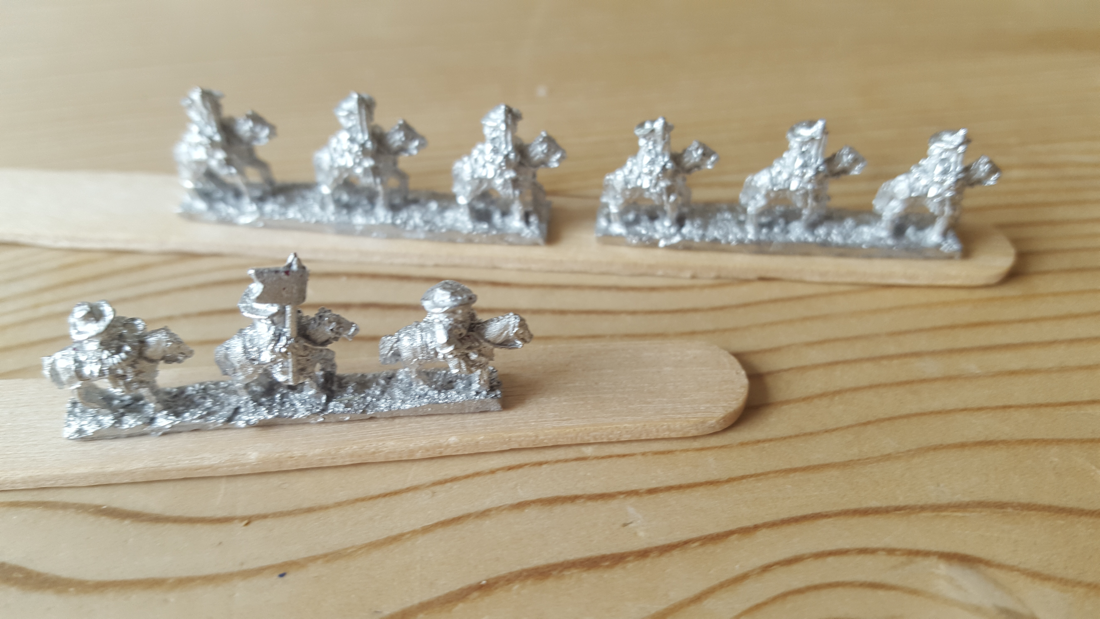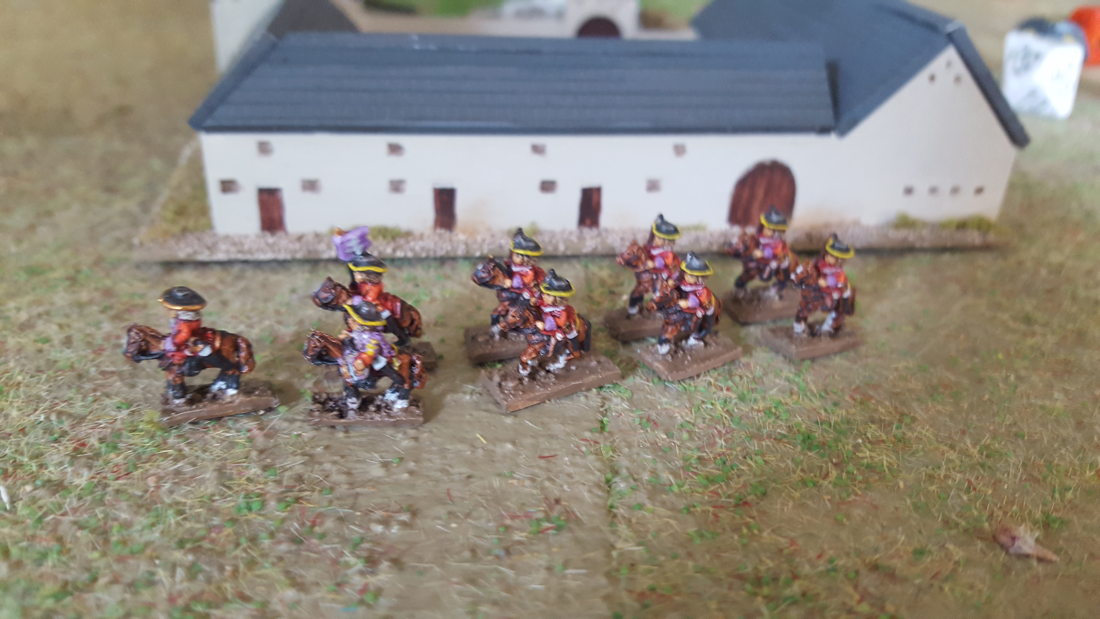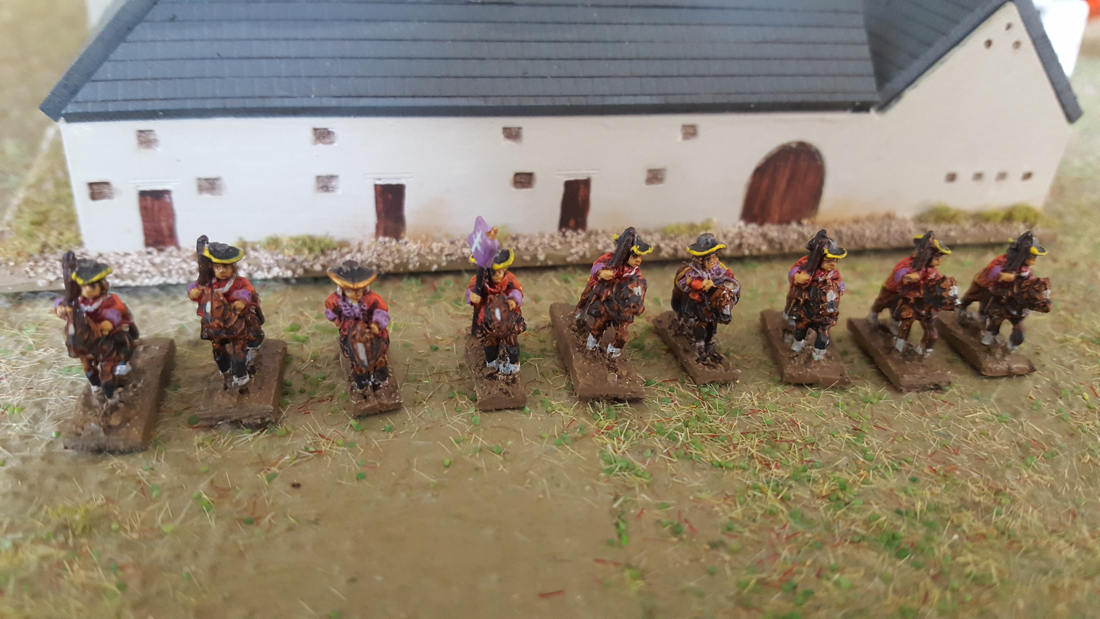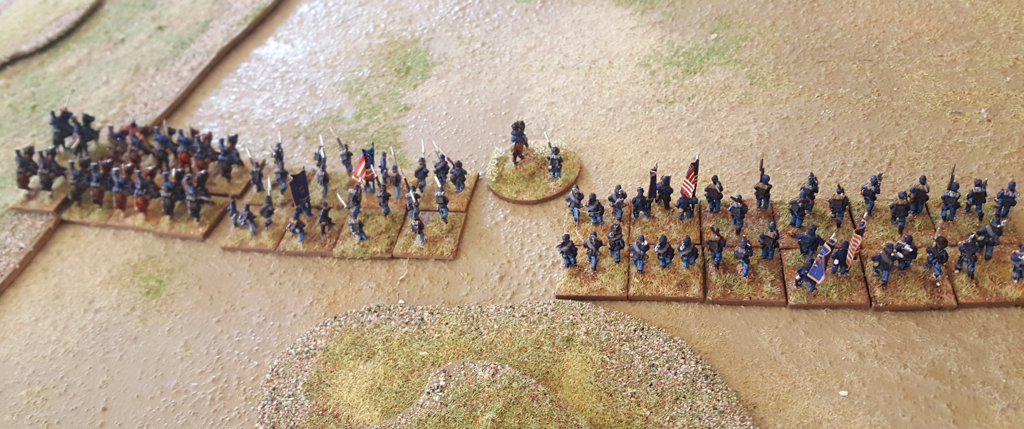|
A few weeks ago I responded to an invitation from Per Broden, 6mm gamer and blogger, to join in a project to build two 6mm armies that will be auctioned for charity. Per had agreed with Baccus Miniatures that the company would send each participant a unit of troops to paint up and contribute to one of two ‘Imagi-nations’ for battles using the Twilight of the Sun King rules, set at the close of the seventeenth century. Per introduces the project on his blog, RollaOne, here. Once collected and based, the armies will be auctioned, with proceeds going to the Combat Stress Charity. Baccus is providing the miniatures for free. I was lucky enough to get in before all the units went and was allocated a regiment of dragoons in the Slavic-themed Army of Siarus. My instructions for painting the Simmutov Dragoons was to give them red jackets and Purple facings. The figures arrived last week and slotted in between two units of 15mm Napoleonic Bavarians. My first non-Airfix wargaming figures were 6mm Heroics and Ros Napoleonics, bought in the mid 1970s when the rangę was very small. I also have two old Heroics and Ros armies for the War of Spanish Succession, which I still theoretically play with, although the last game was Blenheim in 2014. I have added to the Napoleonics in recent years with MDF figures by Commission Figurines. I have bought model buildings and 6mm standards from Baccus as well as a couple of their rule sets, but never tried their figures. I was very interested to see what my dragoons would look like. I was impressed. The figures are chunkier than Heroics, with lots of raised detail and bags of character. I especially liked their little faces! They painted up very easily and responded well to washes. Per provided some useful painting tutorials on his website. I decided to give my dragoons yellow hat- and saddlecloth lace and chose a light purple for the facings which I thought went better against the red jackets than dark purple. The finished unit went in the post on Saturday. I look forward to seeing the completed armies, based and ready for battle. This has been a really fun project that deserves to earn a healthy sum for Combat Stress. When wargame shows resume, I will be tracking down Per Broden to shake his hand and if he’ll let me, buy him a coffee or better still, a beer.
0 Comments
I have been running a second Shenandoah Valley wargame campaign, this time with four new players, two rebels and two Federals. We are using the map and rules from the first campaign (here) but set later in 1862, with more forces and four separate commanders: Frémont and Banks versus Jackson and Ewell. To cater for four players I made one basic change from the historical situation: Ewell is not subordinated to Jackson. Otherwise the troops are based on those present in the historical campaign. The first five turns have seen various skirmishes and one or two bigger actions that I have resolved with weighted dice rolls, using a board game-style combat results table. But this turn we had our first big battle at which both sides were determined to slog it out, so I played this on the table with instructions from the three players whose characters were on the field. The location is Strasburg, on the Valley Pike, where Jackson, played by John, attacks Frémont (Keith) and Banks (Dave) from the West. Jackson had earlier bundled two federal brigades out of Moorefield and then Wardensville. In response the Federals, who had been moving southwards down the Valley, concentrated on Strasburg ready to protect their main supply line. Rules and figures I used the On to Richmond rules published by the Courier in the 1980s. These rules got me into ACW gaming and although I haven’t played them for several years I had fond memories of them. My usual rules, Longstreet or Pickett’s Charge, were too small scale for the numbers involved while OTR uses brigades as units and a scale of 1” to 50 yards. OTR uses a card-activated sequence of play, stand removal and D10 and D100 dice rolls. Figures were 12mm Kallistra figures on 1” frontage bases, two of which counted as one OTR stand. I created a map using Google Maps and historic maps of Cedar Run and Fishers Hill, the two battles that took place historically, one north and one south of Strasburg. I sent briefings to the players that I won’t post yet as the campaign is still happening. The players sent back their dispositions and plans for the battle. I set up the table on Thursday and played the game the next day. Troops engaged: Federals Frémont Cluseret’s Brigade Schenck’s Brigade Milroy’s Brigade Bohlen’s Brigade 3rd West Virginia Cavalry Two artillery battalions Banks 1/Kimball 2/Kimball 1/Tyler One artillery battalion Confederates Jackson 1/Garnett 2/Garnett 1/Fulkerston 2/Fulkerson Connor’s Brigade Three artillery battalions The Federals deployed Cluseret and Schenck in entrenchments along the railway embankment around Strasburg. These were the brigades that Jackson had previously ejected from Moorefield and Wardensville. Artillery was placed in the fort northeast of the town. Other troops were deployed in hiding, some within Strasburg town and some behind woodland in the northeast corner of the table. 3 West Virginia cavalry deployed to the west of the position on Fishers Hill, the high ground south of Tumblers Run. The federal plan was to hide its strength until the rebels had fully committed to an assault. Jackson started with two large brigades on table: Garnett and Fulkerston, each comprising two formations in OTR, plus an artillery battalion. Connor’s brigade arrived from Wardensville soon after with further artillery. Jackson began his attack against the enemy’s left flank, ignoring the federal centre and right. Frémont’s cavalry, defending Fishers Hill, tried to slow Jackson’s advance. The cavalry successfully held up Garnett, the leading Confederate brigade, while Milroy’s brigade, previously out of sight, formed up behind the railway line to complete the federal defensive line facing west northwest. It’s job done and now under great pressure, the cavalry mounted and retired behind the federal earthworks. To Garnett’s left, Fulkerston’s Confederate Brigade advanced in line on the Federal earthworks. Its first volley so disrupted Cluseret’s brigade that the latter abandoned their position. Fortunately for Frémont, as Fulkerston advanced his left wing had come under fire for the first time from federal artillery in the fort and was forced to pause to regroup. This gave time for Bohlen’s Federal brigade, waiting in reserve, to reoccupy the abandoned earthworks before the rebels could reach them. The right wing of Fulkerston ‘s brigade however managed to close with the federal artillery that was now alone behind the earthworks and overran it. Before more rebels could join Fulkerston’s left, it was counterattacked by Bohlen and Cluseret, who had regrouped and returned to the combat. Fulkerston’s whole Brigade now settled into a firefight with the Federals and declined to advance again. Jackson’s reinforcements, Connor’s brigade, now arrived on the table and started moving towards the right flank. At that point two fresh federal Brigades broke cover from the woods in the north-east and marched hard towards the rebel left rear. Brought to a halt in front of the earthworks and now clearly outnumbered, Jackson redirected Connor to face the advancing federal reinforcements and he recalled the troops assaulting the federal left. Under the cover of Garnet’s Brigade, which had only just become meaningfully engaged in the attack, Jackson successfully extracted his right wing. Two of Frémont’s brigades followed up initially but having fought hard all day, they rested on the field, while the two brigades previously defeated by Jackson remained in the entrenchments before Strasburg. Banks took over the pursuit with Kimball’s Brigade and the 3rd West Virginia cavalry, which had passed through the town and moved north to support Banks. Jackson instructed Connor and his supporting artillery to cover the retreat of the other brigades and while this Brigade was mauled by Banks, it gained time for the rest of the rebel army to get clear. As the battle ended Tyler’s brigade arrived to reinforce Banks from Kernstown. Overall Jacksons army had faced odds of over 2 to1 and was fortunate not to suffer more serious losses. His decision to attack the federal left saved him from a much more serious defeat. Banks, hidden in the north-east woodland, had been ready to take Jackson in the left rear once he had become engaged against Frémont. Once it became clear that Jackson would not come round to the north, Banks left hiding in a dash to cut Jackson’s retreat route.
Banks and Frémont dined in Strasburg that evening, satisfied with their success but a little disappointed that Jackson had not been caught completely in their trap. The Federal battle honours for the engagement went to Milroy’s brigade and to Cluseret who, after first running from the enemy, recovered and then helped repulse them from the union position. In Jackson’s army the most resolute troops were Fulkerston’s brigade which made it into the earthworks despite heavy small arms and artillery fire. Garnett was less impressive, allowing himself to be slowed down by a small but determined Federal cavalry regiment. He nevertheless fought a solid fighting retreat and suffered very few losses from the engagement. Connor fought splendidly against superior numbers but paid for his stubbornness. I now have to roll these results into the outturn report. I very much appreciate the readiness of all four players to devote their minds to this campaign and to allow me to determine their fate on the table. It must be frustrating, especially for the side that comes second! |
Archives
November 2023
Categories
All
|









 RSS Feed
RSS Feed